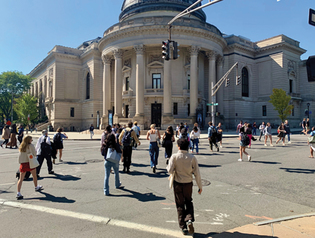
Mark Alden Branch ’86
With a record enrollment this year, more Yalies than ever are crossing at the campus’s busiest intersection in front of Woolsey Hall.
View full image
6,818 undergraduates enrolled at Yale this fall—a record number—meaning campus life is sure to be convivial, and also cramped.
The administration was already anticipating more students than the 6,200 that the college is built to serve, due to the large number of students who responded to the COVID-19 pandemic by taking gap years before or during their time at Yale. Then, about 100 more students than expected accepted Yale’s offer to join the Class of 2027—a record yield of 72 percent.
Yale College dean Pericles Lewis says that’s “good news, because it means we’re attracting more students and we’re very happy about that. But, you know, it does present certain logistical challenges.”
The administration scrambled to make eleventh-hour moves to accommodate everyone. Even so, student leaders report pressures on such finite resources as housing and enrollment in seminars.
Unless they’re married or over 21, Yale requires first-year and sophomore students to live on campus. Juniors and seniors can choose to move off campus or to cast their lot with on-campus housing, knowing that if conditions are crowded, there’s a small chance they will be annexed away from their residential college: perhaps to Old Campus, Arnold Hall, or, in theory, off campus. This kind of calculus happens every year, and Yale Housing assistant director Caitlin Slattery confirms that all undergraduates seeking on-campus housing this year were accommodated. Slattery says that a centralized system allows for Yale Housing to analyze trends and predict inventory pressures.
“During this last housing draw,” she says, “we were able to designate spaces in annex housing for colleges that looked like they might be oversubscribed, though very few students ended up in annex housing due to lack of space.”
Yale College Council vice president Maya Fonkeu ’25 says it still felt like a crunch. “Students feel the larger size of the undergraduate population when it comes to on-campus housing, because of the uncertainty for housing junior year,” she says. “I anticipate policy projects from YCC senators and policy directors will come out at the end of this semester advocating for an earlier housing timeline, because students who have to decide whether or not they want to live on or off-campus need more time to look at off-campus leases.”
Lewis notes that, perhaps as a result of COVID, more students have chosen to live off-campus, which helps to alleviate supply challenges. “And part of it is that New Haven is a very pleasant place to live these days,” Lewis says. “Certainly, there’s a lot of demand in the New Haven housing market, but there’s also been a big expansion in supply.”
Though they’re all housed, Yale College students sometimes find themselves vying for space in the seminar rooms. Seminars by nature entail limited enrollment. But for some, getting into the right intro seminar class could determine whether or not they can complete an important major.
Lewis says that since the university built two new residential colleges and expanded enrollment, the college has taken careful steps to mitigate choke points—like seminar oversubscription—wherever possible. He points out a decade-long effort to match faculty hiring with the growing undergraduate population, but that’s not the only consideration informing long-term faculty hiring goals. Research priorities, graduate education, and Yale College all factor into recruitment, Lewis says. He adds that 2023 has been a “record hiring year,” bringing the number of tenured and tenure-track professors in the Faculty of Arts and Sciences and the School of Engineering and Applied Science to 721—up from 652 in 2018–9.
“We’re assessing the class size and making sure that we can meet demand in certain areas,” Lewis says. “This year, we hired more people to teach introductory writing and math courses. . . . We are just delighted that we’re educating more students than ever before. And, you know, we’re never going to be massive, but we’re able to—because of the residential college system—maintain a certain sense of intimacy, even as the class is a little bit larger than it was when I started 25 years ago.”
Despite the university’s ability to accommodate this time around, Lewis and student leaders are seeing the writing on the wall. The admissions office reviewed 52,303 applications to join the Class of 2027, up by nearly 17,000 compared to the number of students who applied for a similar number of spots just five years ago.
“We’ll just admit fewer students,” Lewis told the Yale Daily News. “Usually we get more applicants each year, so we might be even below 4.2 percent. I don’t like turning away 96 percent of the students. But we can’t admit 50 percent of our applicants.”
Fonkeu says she wants this year’s admissions numbers and on-campus pressures to inform how the increasingly exclusive institution plans to accommodate students who are admitted. “We need to restructure the way housing and course registration operate once you’re in,” she says, “so that people who are in still feel prioritized and still feel supported, and that these things aren’t large stressors for them throughout the year.”
 loading
loading